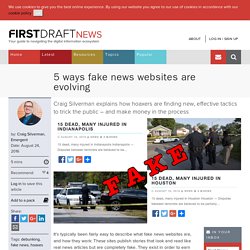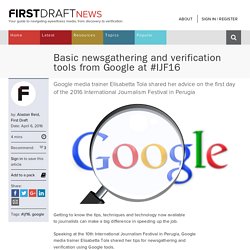

Fact- Checking - Duke Reporters' Lab. This Is The Hashtag Racists Use To Falsely Accuse Black People Of Looting - BuzzFeed News. 7 vital browser plugins for newsgathering and verification - First Draft News. UPDATE – This article was originally published on Jan 6 2016, but has been updated with the first two tools. Know of any others we may have missed? Let us know on Twitter. When breaking news can travel the world in seconds, it is important for journalists to have the tools at their disposal to get to work fast. When searching the web, what quicker way is there to have those tools available than directly in the browser window? Most browsers have a catalogue of programs and software to make your browsing experience more powerful, like a smartphone app store.
Here are five of the most useful browser extensions for finding and checking newsworthy material online. Frame by Frame for YouTube Verifying video often means examining individual frames to figure out exactly what is happening. Here’s where the Frame by Frame plugin comes in, providing an extra set of tools on top of those provided by YouTube itself. Video Vault The VideoVault plugin will let you know when the video has been archived.
5 ways fake news websites are evolving - First Draft News. It’s typically been fairly easy to describe what fake news websites are, and how they work: These sites publish stories that look and read like real news articles but are completely fake.

They exist in order to earn money from ads. That description works for many of the ever-growing number of these sites. But many of them are now evolving in order to find new ways to fool people, and to make money. Here are five things fake news sites are now doing differently. The local viral hoax Hoax stories of terrorist attacks, with only the city name changed, have been popping up on fake news sites recently. #FDLive 2: Trusting social sources (unedited) Verification Junkie. Basic newsgathering and verification tools from Google at #IJF16. Getting to know the tips, techniques and technology now available to journalists can make a big difference in speeding up the job.
When looking for background on a particular story or topic, the site search function is useful, Tola said, by limiting searches for terms to a specific website, and this can be refined further by searching in a specific date range. For example, if searching for CCTV footage uploaded to YouTube after the recent bombing at the Brussels Zaventem airport, the following search could be useful: site:youtube.com brussels zaventem airport CCTV-maalbeek daterange:2457470-2457471 There we have the site search (YouTube); the key words (brussels zaventem airport CCTV); excluding a common word (Maalbeek, where a second bombing happened on the same day); and the date range. – bdobdo
Speaking at the 10th International Journalism Festival in Perugia, Google media trainer Elisabetta Tola shared her tips for newsgathering and verification using Google tools.

Advanced search “The problem we have when we are doing search today is that the amount of information is so huge,” Tola said. “If we’re looking for something specific it might come up on page 14, 15 or 316 [of search results].” But using and combining search operators can help refine searches to drill down to specific results that are more relevant and useful.
Sometimes searches can be scuppered by a particularly common word that isn’t relevant to what you might be looking for. For example, if searching for CCTV footage uploaded to YouTube after the recent bombing at the Brussels Zaventem airport, the following search could be useful: Foller.me Analytics for Twitter. How to find geolocated posts on Instagram. France24’s The Observers. How to verify photos and videos on social media networks. This image was mistakenly broadcast by one of France’s largest TV channels, France 2.

The scene was described as having unfolded in Iran, back in December 2009. A cursory glance reveals a range of details that could allow us to verify its authenticity. Are Iranian police shields the same colour as in this image? Are Tehran’s pavements painted yellow? Is that really how young Iranians dress? The photo was actually taken in Honduras. Another example, far more recent, relates to the migrant crisis in Europe, a favourite theme for those who wish to mislead the European public.
According to the caption posted to YouTube, the video depicts violence at the hands of migrants in Erfurt, a city in central Germany. Google Maps, Google Earth, and Google Street View To really scrutinise a photo or a video, you have to get up close and personal. Time for a pop quiz! Here, no attempt has been made to mislead the viewer. Google Street View Who's the author ? Then, listen to the words. Jeffrey Friedl's Image Metadata Viewer.